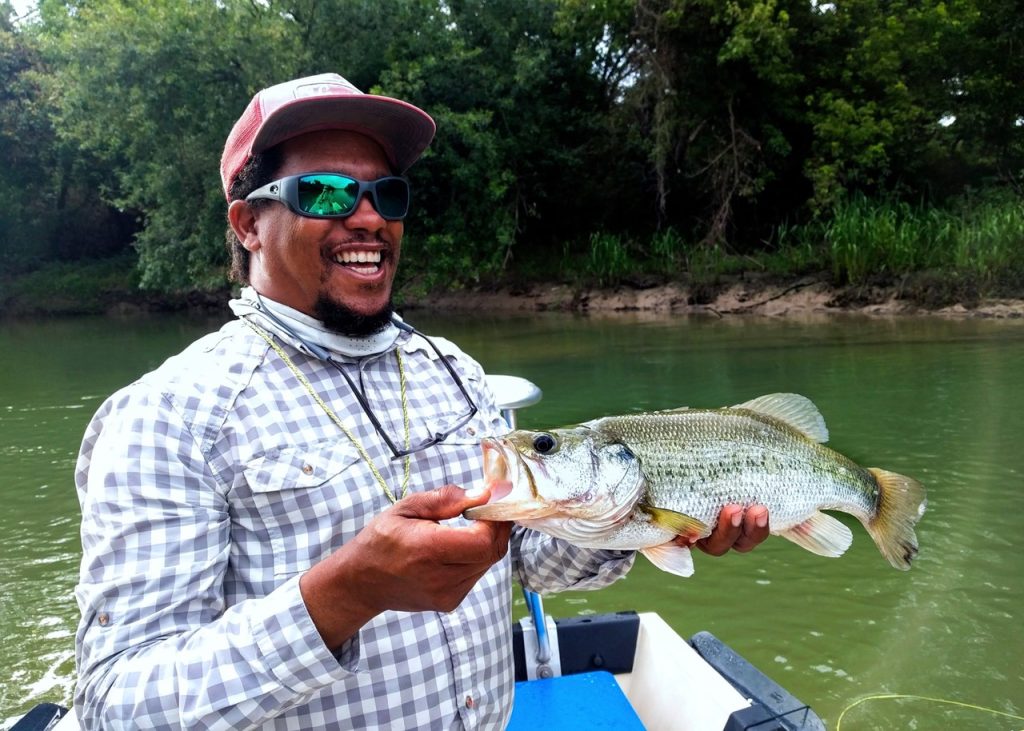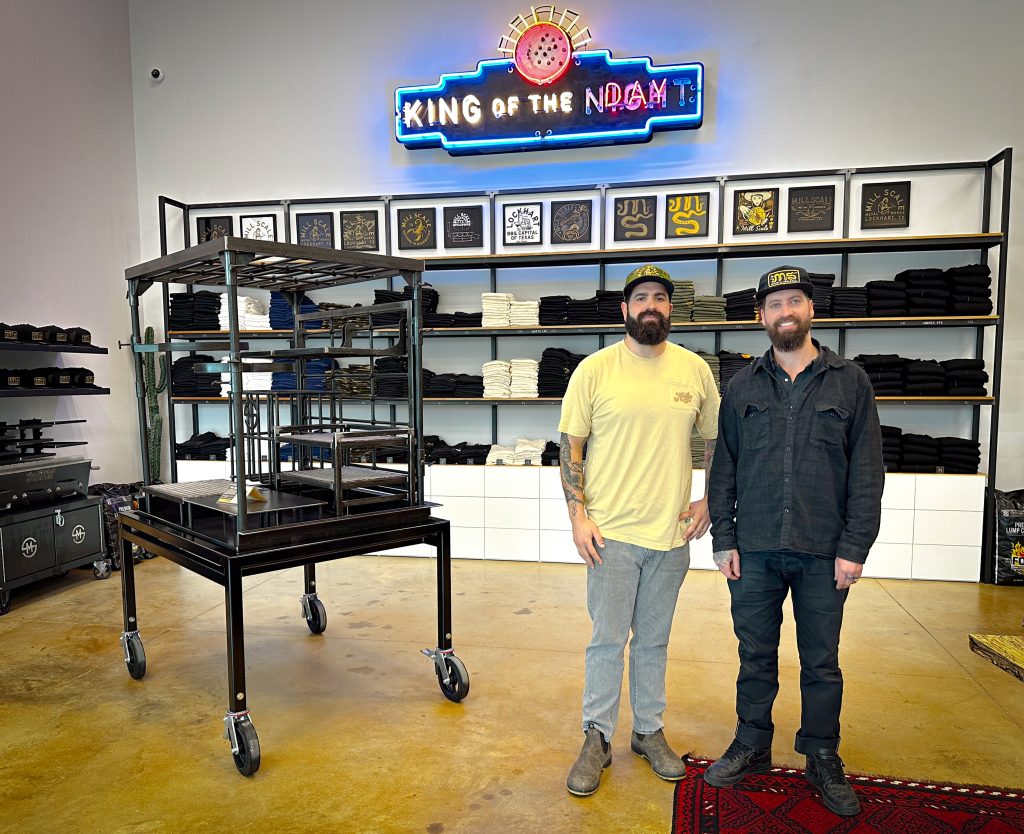
The Czech Stop in West opens 24 hours for travelers who can’t make it another mile without a kolache. Photo by Michael Amador.
Warm weather has arrived, and so has the urge for adventure. The first of our two-part spring road trips series takes you on three different journeys: a kolache trail that offers two different routes to find the delicious Czech pastry; a drive following the steel arrows that recall the 19th-century era of Comanche Chief Quanah Parker; and an overnight journey following the historic El Camino Real, also known as the King’s Highway. Each trip offers its own vibe, if you will, so you know what to expect when you hit the road.
The Kolache Trail
Trip Mileage: About 250
Overall Vibe: Filling
The kolache, the Czech-inspired breakfast sweet, is ubiquitous in Texas. If a shop sells doughnuts, odds are kolaches are also available, filled with fruit, jellies, jams, cream cheese, and, in the case of the klobasnek, small sausages (aka pigs in a blanket).
Drive any main route inside the Texas urban triangle of Houston, Dallas-Fort Worth, and Austin-San Antonio, and you’ll find kolaches. Hope you’re hungry, because this 200-plus-mile meander takes you away from the cities and the interstates to two dozen spots where the baked delicacy—along with the greeting Jak se mas!—rules.
 You might as well start in West, located on Interstate 35 about 20 miles north of Waco—and you might just as well end there, too. This community of 2,860 has six bakeries that specialize in kolaches. The frontage-road establishments of Czech Stop/Little Czech and Kolache House Baking Company (northbound, located in the CEFCO convenience store) and Slovacek’s (southbound) get the highway traffic. But I prefer driving a couple blocks east to Oak Street where the Oak Street Bakery, Gerik’s Ole’ Czech, and West Donuts and Kolaches are clustered.
You might as well start in West, located on Interstate 35 about 20 miles north of Waco—and you might just as well end there, too. This community of 2,860 has six bakeries that specialize in kolaches. The frontage-road establishments of Czech Stop/Little Czech and Kolache House Baking Company (northbound, located in the CEFCO convenience store) and Slovacek’s (southbound) get the highway traffic. But I prefer driving a couple blocks east to Oak Street where the Oak Street Bakery, Gerik’s Ole’ Czech, and West Donuts and Kolaches are clustered.
Once you’ve had your fill of kolaches in West, head about 13 miles south and then east on Heritage Parkway/Farm to Market Road 2311, through Leroy to State Highway 31 West. Then go 12 miles to the State Highway 340 loop around Waco, picking up US 77 South for 27 miles to Lott. In town, turn onto State Highway 320 South to Miller’s Country Smokehouse, a destination deli and bakery that also happens to serve kolaches.
Continue south on SH 320, then west on State Highway 53 for a half mile to the tiny town of Zabcikville, named for the family of Czech immigrants that settled there. Here is where you’ll find Green’s Sausage House, a café, meat counter, and bakery established in 1946. Eight fruit varieties are offered daily, along with eight different kinds of “meat kolaches” including the exotic knockwurst with jalapeños and cheese and boudin with jalapeño cheese.
Head back east and south on Farm to Market Road 485 for 14 miles, crossing US 77, and pick up Farm to Market Road 979 for 16 miles to Calvert and Pappy’s Bakery, a full-service bakery with six varieties of fruit kolaches and regular or jalapeño sausage klobasnek. Then, it’s about 30 miles south on State Highway 6 to one of three Kolache Rolf’s locations in College Station, the house specialties being an array of traditional kolaches along with four varieties of savory kolaches including bacon and cheese.
Leaving Aggieland, take State Highway 47 north to State Highway 21 West, a 27-mile jog to Caldwell, home of the Caldwell Kolache Festival held on the second Saturday in September. Tucked next to a convenience store is Nonnie’s Bakery, where the handmade kolaches (including coconut) sell out early.
From Caldwell, continue south on SH 21 for 10 miles, then turn right and go west on Farm to Market Road 696 for 14 miles to Lexington. Cheese pigs are the top item on the breakfast menu at Herk’s Store and Grill. From here, it’s 37 miles south on US 77 to Weikel’s Bakery in La Grange (a second bakery is located in Brenham). This spot features at least 20 flavors of kolache and five kinds of what they call klobasniky—their term for pig-in-a-blanket. Another popular place, one Gary McKee, the publisher of Texas Polka News prefers for their pigs, is at Lukas Bakery in downtown La Grange.
From La Grange, you have two options for a last stop on your kolache odyssey. Twelve miles east of LaGrange on SH 71 is Hruska’s Bakery in the community of Ellinger. This is arguably the most popular kolache stop between Austin and Houston, with the usual lineup of pigs, fruit kolaches, seven cream cheese varieties, and even cottage cheese kolache. Or go to downtown Schulenburg, 16 miles south of La Grange on US 77, for the home of the Besetsny family’s original Kountry Bakery (other locations can be found in Weimar, Victoria, Hallettsville, and Eagle Lake). Choose from 16 varieties of kolaches sold individually and by the box.

East-West Alternate Kolache Trail
Trip Mileage: 168
You can’t namedrop kolaches in Texas without involving the Houston area and US 90. For an alternative kolache route, begin in the settlement of Danbury, a few miles northeast of Angleton, at the Two Czech Chicks Bakery. The owners, Jennifer Martin and Dawn Sykora, grew up in West, but many of the recipes were passed down by the Czech grandmother of Sykora’s husband.
From Angleton, take State Highway 288 South about 10 miles to Clute, where the Kolache Shop features a flavor of the month, such as Italian Cream and Chocolate-Covered Cherry. Pick up State Highway 36 and head northwest for an hour to downtown Rosenberg, home of the Old Main Street Bakery. From Rosenburg, take US 90A and head west for 16 miles. Next stop is Vincek’s Smokehouse in East Bernard, a community that hosts the Kolache and Klobase Festival in June.
If you continue on 18 miles west on Alt 90 to Eagle Lake, you can stop at one of the Besetsny family’s Kountry Bakery locations. Then it’s 38 miles to Hallettsville, where the annual Hallettsville Kolache Festival in late September is the town’s big civic bash. Hallettsville has another Besetsny family Kountry Bakery. At this point, if you haven’t fallen into a kolache food coma, head to Shiner, another 15 miles west on US 90A, where Bea’s Place convenience store preps serious pigs in a blanket.

A view of the Comanche Medicine Mounds at dusk. Photo by Dave Shafer.
Quanah Parker Trail
Total distance: About 280 miles.
Overall vibe: Indigenous territory
The Quanah Parker Trail consists of 86 stainless steel arrows, each 22 feet long, placed at locations associated with the Comanche people and their last chief, Quanah Parker. There is no route per se, but the Quanah arrows are scattered pretty much everywhere around the Panhandle, South Plains, and the Notch, that corner of the state where the Panhandle starts and the Rolling Plains ends, west of Wichita Falls. Charles A. Smith of New Home in Lynn County sculpted the arrows for the trail program, which was initiated in 2011. With the guidance of Quanah Parker resource W.K. Stratton, who wrote about the Comanche Medicine Mounds in the January 2022 issue of Texas Highways, I’ve conjured a more specific, pared-down Quanah Parker Trail.

The first Quanah arrow for this day drive starts northwest of Amarillo at the Wildcat Bluff Nature Center just off Loop 335. This dedicated open space offers a network of hiking trails and a taste of the sprawling hills, plains, canyons, and rivers that were once part of Comanche domain. Then it’s 16 miles across town to the Kwahadi Museum of the American Indian on Interstate 40 East. This museum, trading post, and event center features exhibits about Native American culture, including a Navajo rug collection and indigenous birds display, along with seasonal dance performances throughout the year. The museum is open on weekends during winter months and Thursday through Sunday in the summer.
Take I-40 until it trails off to US 287, then drive 20 miles to Claude, turning south on State Highway 207 and going 12 miles to where the rolling plains suddenly break into the buff red and orange crags and cliffs marking the east end of Palo Duro Canyon. The Quanah arrow at the roadside picnic area at Wayside on the south side of the canyon is placed there to underscore the significance of Palo Duro to the Comanche, both economically and spiritually.
More arrows are 13 miles south at Tule Canyon and Lake MacKenzie. This is close to the site of the Battle of Palo Duro Canyon, where on Sept. 28, 1874, Gen. Ranald MacKenzie of the U.S. Army ordered the slaughter of somewhere between 1,000 and 2,000 horses captured from the Comanche, ruthlessly forcing the people to walk to the reservation in Oklahoma and effectively ending their way of life.
Heading south, when you near Silverton, go east on State Highway 86, dropping off the Caprock onto the rolling plains of Quitaque. Pronounced “kitty-kway,” the town is known for being the official Bison Capital of Texas. This frequent Comanche lingering place, laced with creeks and rivers, is where the tribe conducted considerable trade with Comanchero settlers to the west in the early 19th century, memorialized at the Comanchero Canyons Museum. For a sense of how this land must have looked 200 years ago, go just outside Quitaque to Caprock Canyons State Park. A distant miniature of Palo Duro Canyon, it harbors the official state bison herd.
Next up is Turkey, 9 miles east of Quitaque on SH 86. Then, drive 28 miles south on US 70 through some spectacular ranching country to Matador.
Matador was a frequent destination for Quanah Parker before and after capture. Roaring Springs, about 10 miles south on SH 70 on the South Pease River, was a Comanche campground valued as a clean abundant water source. “Just south of town, on Teepee Creek, is where Quanah began the Comanche’s Trail of Tears, leading the last band to, eventually, captivity at Fort Sill,” W.K. Stratton says. The Hotel Matador Bed and Breakfast, a nine-room restored hotel, is a fine place to stay overnight on this Quanah trail.
The 30-miles-long US 62 and US 70 route between Matador and Paducah was homeland for Quanah’s family before and after enslavement. Local ranchers welcomed Parker and his close kin to hunt and take beef. The Cottle County Heritage Museum in Paducah’s old train station on Ninth Street (US 83) displays artifacts from both periods of Parker’s life.
Continue east on US 70 to Crowell and see the Quanah arrow that marks the site where Cynthia Ann Parker, the mother of Quanah Parker who was raised Comanche after her capture as a child, was recaptured by Texas Rangers in 1860, along with her daughter, Topsannah.
Nine miles north of Crowell on State Highway 6 is Copper Breaks State Park, which has exhibits about Comanche who camped on this very same land near the Pease River a couple hundred years ago, treasuring it as a sacred spot.
Namesake town Quanah is 12 miles further north on SH 6. “Just south of the current town of Quanah is where the Kwahadi had their last encampment as free people in Texas before heading north and east to cross the Red River into Oklahoma,” W.K. Stratton says. At the Hardeman County Historical Museum in the old train station with “The Quanah Route” logo, you can view photographs of Quanah Parker’s frequent visits to “my town.”
Five miles east of Quanah on US 287 is the Farm to Market Road 1167 turnoff to the ghost town Medicine Mound and the actual medicine mounds. Visible from the road on clear days, these four dolomite hills were regarded as sacred spots by the Comanche and Kiowa who camped nearby.

Mission Tejas State Park. Photo by Michael Amador.
El Camino Real de Tejas
Trip mileage: 530
Overall vibe: the path well-tread
Have a few days of idle time and want to do some serious road tripping? Trace the most famous footpath in what is now Texas.
First blazed as a trade route by various First American tribes, El Camino Real was designated the King’s Highway in 1690 to link New Spain (Mexico) with colonists and military in the Red River Valley of Louisiana, where the first provincial capital of Tejas was established at Los Adaes from 1729 to 1770. With Texas independence came offshoots of the route, including Old San Antonio Road. This part of El Camino can run 530 miles in length, so the trip is best undertaken as a two- or three-day adventure.

Be true to the journey and start where most immigrants did, near State Highway 21 in Milam and the Sabine National Forest on the western banks of the Sabine River. Or begin 57 miles west in Nacogdoches—with a deep, funky, and very provincial history all its own, there are plenty of reasons to linger here a while before hitting the trail.
Go west for about 30 minutes on SH 21 to Mission Tejas State Park, marking the first Spanish mission in what is now Texas. Built in a village of Caddo Indians, it was burned down, and today the Caddo Mounds State Historic Site marks the village and ceremonial center of the Caddo people and a trading hub before the Europeans arrived.
The modern world intrudes as you move through Crockett and hit the 203-mile section that takes you to Bryan via SH 21 and the OSR (State Highway Old San Antonio Road) bypass, then, also on SH 21, to Caldwell, Paige, Bastrop, and San Marcos. Congestion is frequent, speed traps are numerous, and the landscape leans exurban. From San Marcos, drive 50 miles on Interstate 35 to San Antonio, where the Mission Trail links the Concepcion, San Jose, San Juan, and Espada missions in San Antonio Missions National Historical Park.
Moving south on State Highway 16 to Jourdanton, this section transverses the Brush Country, a wide-open space that pretty much remains wide open today, other than the fracking along the Eagle Ford shale. In Jourdanton, see the replica of the mid 19th-century log cabin courthouse that sits right across from the present-day Atacosa County Courthouse, built in 1912. Then turn west and head 80 miles to Carrizo Springs, where you can grab a bite at Miguelito’s Mexican Grill and Cantina, a sweet relaxing stop located in an old house with a large yard on Petry Place.
From here, take Farm to Market Road 1644 to El Indio, then 6 miles south on Farm to Market Road 1021, where you’ll be near the five historic crossings on the Rio Grande to Mission San Bernardo, dating back to 1702 and near the town of Guerrero, Coahuila, Mexico. Once upon a time, this and two other nearby missions, whose crumbling walls are now protected, functioned as the gateway to New Spain and Mexico City, much like Laredo to the southeast and Eagle Pass to the northwest do today. The harsh tamaulipan thornforest countryside looks as lonely and forbidding as it must have looked more than 300 years ago, even with the constant presence of the Border Patrol and other law enforcement agencies on this side of the river.
The Texas part of the road ends here, although you can pick it up going 16 miles north on FM 1021 to Eagle Pass and crossing into Piedras Negras, Coahuila (make sure you bring along your passport), then south 20 miles on MX 2 to Guerrero, now an official Pueblo Magico (or magical towns), and the mission.








